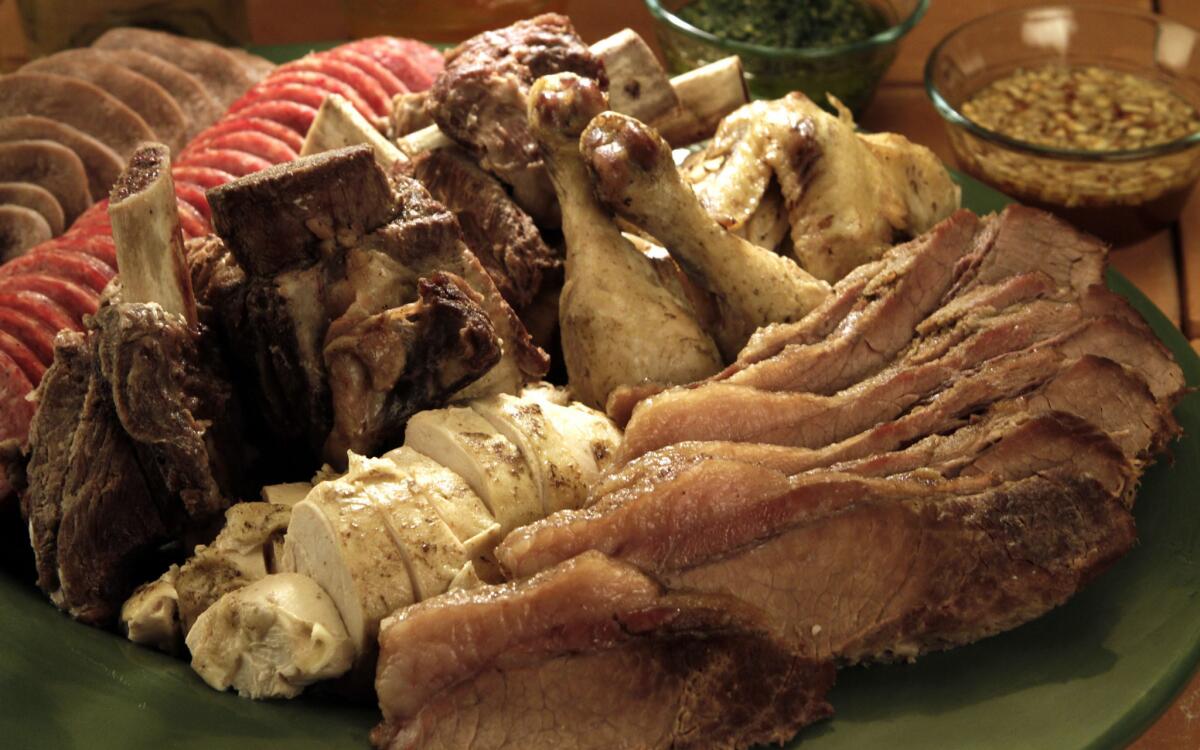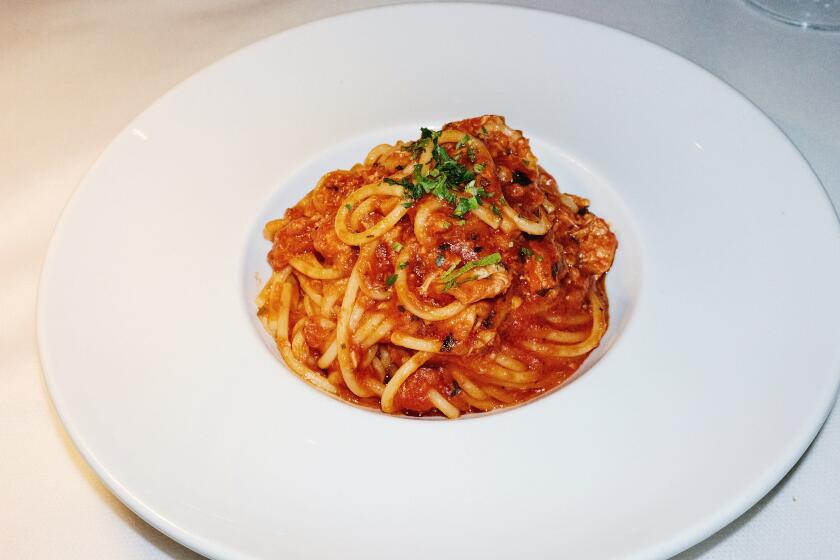Bollito misto

OK, it’s hardly bollito misto weather. But we can pretend. At least once every winter, I need to make the “mixed boiled meats” of northern Italy, one of the easiest and most festive meals I know. By rights, snow should be deep outside the window, but here we are, with the temperature nowhere near freezing. Only a few days ago, Angelenos were walking around in shorts. And you know what? Bollito misto suits milder weather just fine.
I’ve had it in Modena served from elaborate silver carts in a posh restaurant, at my friend Elena’s house in Milan and, most memorably, in Piedmont, land of Barbaresco and Barolo — and also an extraordinary breed of cattle called razza Piemontese. That’s the 4-year-old “veal,” used to make the region’s famous carne cruda — raw meat hand-chopped and perfumed with just a thread of olive oil and maybe a drop of lemon or a shaving of white truffles.
Every December, the market town of Carrù is the site of the fiera di bue grasso (“fair of the fattened livestock”). It may be snowing, it may be bitter cold, but the proud owners bring out their beasts and parade them before the judges. “It’s like a beauty contest, almost like judging bodybuilding,” Emmanuella Currado Cordero, a local veterinarian, told me. Afterward, the winners, the mayor and the butchers convene at Ristorante Moderno to feast on boiled calf’s head, tongue, tail and various parts of the animal.
The dining room has travertine floors, plain wood wainscot and wooden chairs with rush seats. The sole decorations are framed menus from the 1920s and ‘30s and a collection of antique plates from the once-famous ceramic center of Mondovì. Once you sit down, a server will propose antipasti one by one. And then she’ll list the primi, perhaps a risotto or the famous tajarin (tagliatelle) of the region.
Go easy, because soon a cart will roll up to the table laden with the bollito misto, and you’ll be asked which meats you prefer — a little calf’s head, oxtail, short ribs, brisket, chicken, cotechino sausage — or tongue? A little of each is a good idea. And maybe some potato purée.
The meat comes with several sauces, including a sharp, fragrant bagnet verd (a.k.a. salsa verde), some mostardo (preserved fruits with mustard) and a hazelnut and wild honey sauce, a house specialty. Usually, there’s also cugnà, a grape conserve made from fresh grape must and pears cooked together with a cinnamon stick and a few cloves.
Of course you’re drinking Piedmontese wine — maybe a velvety Barbera from Vietti, an expressive Barbaresco from Gaja or Produttori del Barbaresco (depending on how flush you’re feeling) or a profound Barolo from Sandrone, Altare or Clerico.
It’s a feast to be savored over hours, bite by bite, sip by sip. Each of the meats has been cooked in the simmering broth until it’s perfectly done. And though the dish sounds dishearteningly plain, because of the quality of the ingredients, it has a clarity of taste that can be a revelation. Those piquant sauces add just enough contrast to keep things interesting. Such a plain meal, too, shows off the gorgeous wines. And because there’s very little fat and no heavy sauces, bollito misto is a lighter meal than you’d think, a wonderful way to honor all the various parts of the animal.
We may not have a cattle fair here in L.A., but there’s no reason we can’t celebrate winter, such as it is here in Southern California, with bollito misto.
irene.virbila@latimes.com
In a very large pot, combine the onions, celery, carrots, rosemary, cloves, peppercorns, short ribs, brisket, oxtail, calf’s foot and tongue, chicken and garlic. Add enough water to cover all of the meats and vegetables, and bring to a boil. After 10 to 15 minutes, reduce the heat and continue to simmer to gently cook the meats.
While the meats are stewing in the large pot, in a smaller pot cover the sausage with enough water to cover. Bring to a simmer and cook until the sausage is firm and cooked through, about 1 hour. Drain and hold in a warm place.
Continue to cook the meats in the large pot until each are cooked through, 1 to 21/2 hours, then remove to a platter and hold in a warm place. The chicken will be done when the meat is firm, the joints move easily and a thermometer inserted into the meat between the breast and thigh reaches 165 degrees, about an hour. The short ribs, brisket and oxtail will be done when a knife pierces easily, about 2 hours. The tongue will also be done when a knife pierces easily, 1 to 2 hours, depending on the size of the tongue; as soon as the tongue is done, remove and peel the outer layer of skin while the tongue is hot (the skin will be harder to peel as the tongue cools).
Strain the vegetables and flavorings from the broth, and bring the broth to a simmer to reduce it slightly, 20 to 30 minutes. While the broth is reducing, prepare the sauces.
When the broth is almost ready, carve the meats and arrange on the platter. Spoon a little broth over the meats to moisten, and serve with the bagnèt verd and, if you like, the hazelnut and honey sauce and a jar of mostarda.
Bagnèt verd
Finely chop together the parsley, garlic, anchovies, capers, celery, onion and chile. Combine in a bowl and add the salt, vinegar and oil, stirring together. The mixture should have the consistency of a thick sauce. Adjust the texture, consistency and flavorings as desired. This makes about half a cup of bagnèt verd.
Hazelnut and honey sauce
In a small bowl, combine the honey, mustard and hazelnuts. If the honey is dense and thick, thin the sauce with a tablespoon or so of broth, adding just a tiny amount at a time. The sauce should have a creamy consistency. This makes a generous cup of sauce.
Get our Cooking newsletter.
Your roundup of inspiring recipes and kitchen tricks.
You may occasionally receive promotional content from the Los Angeles Times.















